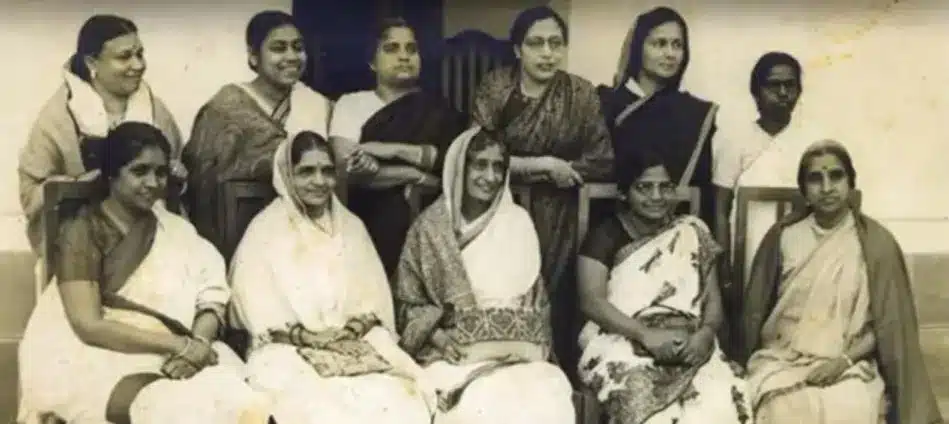What’s in today’s article?
- Why in News?
- Ammu Swaminathan (1894-1978)
- Annie Mascarene (1902-1963)
- Begum Qudsia Aizaz Rasul (1909-2001)
- Dakshayani Velayudhan (1912-1978)
- Renuka Ray (1904-1997)
Why in News?
On Constitution Day (November 26), President Droupadi Murmu highlighted the contributions of women in India’s Constituent Assembly.
The 299-member body included 15 women (two later resigned), representing diverse regions and perspectives. Prominent figures like Sarojini Naidu, Sucheta Kripalani, and Vijaya Lakshmi Pandit were joined by lesser-known women who actively engaged in debates on critical issues such as gender, caste, and reservations.
This article highlights the contributions of five of these women.
Ammu Swaminathan: A Pioneering Voice for Women in the Constituent Assembly
- Swaminathan, from Palakkad, Kerala, married Subbarama Swaminathan in her teens, setting conditions like independence in daily life. Among her children was Captain Lakshmi Sahgal of the Indian National Army.
- Her political interest stemmed from opposing restrictive widowhood practices she witnessed her mother endure.
- Swaminathan contested elections on a Congress ticket and, as a member of the Constituent Assembly, advocated for the Hindu Code Bill and gender equality, despite resistance from the male-dominated House.
- Post-independence, she was elected from Dindigul, Tamil Nadu, and served as India’s goodwill ambassador to countries like Russia, China, and the US.
Annie Mascarene: Advocate for Universal Franchise and Local Autonomy
- Annie Mascarene (1902–1963) was born into a Latin Christian family in Travancore, considered the lowest caste tier.
- Despite societal barriers, she excelled academically, studied law, and became an educator.
- Influenced by caste and gender reforms initiated by Travancore royals, she became politically active during the region’s upheaval.
- Mascarene joined the All Travancore Joint Political Congress and later the Travancore State Congress, championing universal adult franchise and enduring violence from opponents.
- As a member of the Constituent Assembly, she advocated for a strong Centre while supporting local government autonomy.
- After leaving the Congress due to state factionalism, she won as an independent candidate from Thiruvananthapuram in 1952, marking a significant achievement in Indian politics.
Begum Qudsia Aizaz Rasul: A Trailblazing Woman in Politics
- Begum Qudsia Aizaz Rasul (1909–2001), born into Punjab’s royal family, pursued formal education despite opposition, including a fatwa against her convent schooling.
- After marrying Nawab Aizaz Rasul, she discarded the purdah and entered politics, winning a non-reserved seat in 1936 despite conservative criticism.
- As a member of the Muslim League, she campaigned for women’s issues and opposed separate electorates based on religion.
- While initially seeing potential benefits for Muslims in the idea of Pakistan, she ultimately chose to stay in India, concerned for poor Muslims left behind post-Partition.
- She later joined the Congress, served in the Rajya Sabha from Uttar Pradesh in 1952, and contributed to promoting women’s hockey in India.
Dakshayani Velayudhan: A Pioneer for Dalit Rights and Equality
- Dakshayani Velayudhan (1912–1978) achieved multiple milestones as the first Dalit woman to graduate in science in Cochin and serve in the Cochin Legislative Council.
- Belonging to the Pulaya community, considered “slaves” at the time, she defied caste barriers, enduring discrimination, such as being excluded from practical experiments in college.
- After working as a teacher, she married a social worker in a simple wedding officiated by a leprosy-afflicted person in the presence of Mahatma Gandhi and Kasturba.
- Elected to the Constituent Assembly in 1946, she opposed Ambedkar’s call for separate electorates, arguing it promoted division and hindered nationalism.
- Financial struggles prevented her from pursuing a sustained political career, although she remained active in the Dalit movement.
- She returned to politics in 1971 but finished fourth in the Lok Sabha elections as an independent candidate.
Renuka Ray: A Trailblazer for Women’s Rights
- Renuka Ray (1904–1997), born in Pabna (now in Bangladesh), hailed from a distinguished family.
- Inspired by Mahatma Gandhi in 1920, she left college to join the freedom struggle, raising awareness through grassroots efforts and briefly staying at Sabarmati Ashram.
- She later pursued studies at the London School of Economics, where she met her future husband, Satyendra Nath Ray.
- After returning to India, Ray championed women’s rights, focusing on divorce and inheritance laws.
- Representing women’s organisations in the Central Legislative Assembly in 1943, she joined the Constituent Assembly in 1946.
- She supported the Hindu Code Bill but opposed reserved seats for women in legislatures, viewing it as a hindrance to their progress.
- Although she lost the 1952 general election from Hooghly, she won in 1957 and contributed to governance in Bengal before returning to social work.
- Her life reflected her commitment to advancing women’s empowerment and social justice.
Q.1. Who were some notable women in the Constituent Assembly?
Prominent figures included Ammu Swaminathan, Dakshayani Velayudhan, Annie Mascarene, Renuka Ray, and Begum Qudsia Aizaz Rasul, each contributing to debates on gender, caste, and equality in drafting the Constitution.
Q.2. What challenges did these women face during their political careers?
These women overcame societal barriers like caste discrimination, religious opposition, and patriarchal resistance while advocating for equality, education, and political reforms in pre- and post-Independence India.
News: Explained: Stories of women who helped draft the Constitution of India
Last updated on December, 2025
→ Check out the latest UPSC Syllabus 2026 here.
→ Join Vajiram & Ravi’s Interview Guidance Programme for expert help to crack your final UPSC stage.
→ UPSC Mains Result 2025 is now out.
→ UPSC Notification 2026 is scheduled to be released on January 14, 2026.
→ UPSC Calendar 2026 is released on 15th May, 2025.
→ The UPSC Vacancy 2025 were released 1129, out of which 979 were for UPSC CSE and remaining 150 are for UPSC IFoS.
→ UPSC Prelims 2026 will be conducted on 24th May, 2026 & UPSC Mains 2026 will be conducted on 21st August 2026.
→ The UPSC Selection Process is of 3 stages-Prelims, Mains and Interview.
→ UPSC Result 2024 is released with latest UPSC Marksheet 2024. Check Now!
→ UPSC Prelims Result 2025 is out now for the CSE held on 25 May 2025.
→ UPSC Toppers List 2024 is released now. Shakti Dubey is UPSC AIR 1 2024 Topper.
→ UPSC Prelims Question Paper 2025 and Unofficial Prelims Answer Key 2025 are available now.
→ UPSC Mains Question Paper 2025 is out for Essay, GS 1, 2, 3 & GS 4.
→ UPSC Mains Indian Language Question Paper 2025 is now out.
→ UPSC Mains Optional Question Paper 2025 is now out.
→ Also check Best IAS Coaching in Delhi

















